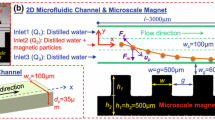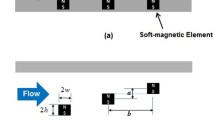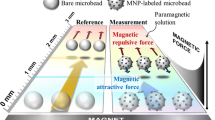Abstract
Magnetophoretic isolation of biochemical and organic entities in a microfluidic environment is a popular tool for a wide range of bioMEMS applications, including biosensors. An experimental and numerical analysis of magnetophoretic capture of magnetic microspheres in a microfluidic channel under the influence of an external field is investigated. For a given microfluidic geometry, the operating conditions for marginal capture is found to be interrelated in such a manner that a unique critical capture parameter \( \Pi _{{{\text{crit}}}} = {{\left( {I_{{{\text{crit}}}} {\text{a}}} \right)}^{2} } \mathord{\left/ {\vphantom {{{\left( {I_{{{\text{crit}}}} {\text{a}}} \right)}^{2} } {{\text{Q}}\eta }}} \right. \kern-\nulldelimiterspace} {{\text{Q}}\eta } \), that is proportional to the ratio of the magnetic force to viscous force, can be identified. Influences of the flow rate, magnetic field and other parameters on the particle trajectories in the microfluidic channel are investigated both numerically and through bright-field imaging under a microscope. Like the event of critical capture, particle trajectories are also found to be guided by a similar parameter, π. Magnetophoretic capture efficiency of the device is also evaluated as a function of a nondimensional number \( \Pi ^{*} = {\chi {\text{P}}^{2} {\text{a}}^{2} } \mathord{\left/ {\vphantom {{\chi {\text{P}}^{2} {\text{a}}^{2} } {{\left( {{\text{U}}_{0} \eta {\text{h}}^{5} } \right)}}}} \right. \kern-\nulldelimiterspace} {{\left( {{\text{U}}_{0} \eta {\text{h}}^{5} } \right)}} \), when both numerical and experimental results are found to agree reasonably well. Results of this investigation can be applied for the selection of the operating parameters and for prediction of device performance of practical microfluidic separators.








Similar content being viewed by others

Abbreviations
- a:
-
Particle radius (m)
- CE:
-
Capture efficiency (dimensionless)
-
 :
: -
Unit vectors along r and \( \phi \)
- F d :
-
Drag force by the fluid on a particle (N)
- F m :
-
Magnetic force on a particle (N)
- h :
-
Height of the straight channel, and the straight section of T-channel (m)
- H :
-
Magnetic field (A/m)
- Kwall, K ∥wall , K ⊥wall :
-
Wall drag multipliers
- L:
-
Channel length (m)
- l w :
-
Distance of a particle from the wall
- p:
-
Pressure (Pa)
- P:
-
Dipole strength (per unit depth of a dipole line) (A-m)
- Pix:
-
Pixel value (Arbitrary unit)
- Q:
-
Flow rate (ml/h)
- r :
-
Position vector (m)
- Re:
-
Reynolds number (dimensionless)
- dtL :
-
Time step for integration for Lagrangian tracking (s)
- t:
-
Time (s)
- U:
-
Slip velocity between particle and fluid (m/s)
- Umax :
-
Maximum flow velocity (m/s)
- V :
-
Velocity of fluid (m/s)
- V p :
-
Velocity of particle (m/s)
- (x, y):
-
Coordinate references
- (x mag, y mag):
-
Coordinates of the virtual origin of the dipole line (m)
- χ:
-
Effective magnetic susceptibility of magnetic microspheres
- χi :
-
Intrinsic magnetic susceptibility of magnetic microspheres
- η:
-
Viscosity of fluid (N-s/m2)
- λ:
-
Particle number density (m−3)
- μ0 :
-
permeability of vacuum (=1.257 × 10−6 N/A2)
- \( \phi \) :
-
Angular position
- Π:
-
\( {{\left( {{\text{I}}^{2} {\text{P}}^{2} } \right)}} \mathord{\left/ {\vphantom {{{\left( {{\text{I}}^{2} {\text{P}}^{2} } \right)}} {{\left( {\eta {\text{Q}}} \right)}{\left( {{\text{m}}^{5} } \right)}}}} \right. \kern-\nulldelimiterspace} {{\left( {\eta {\text{Q}}} \right)}{\left( {{\text{m}}^{5} } \right)}} \)
- Π*:
-
\( {{\left( {a^{2} \chi _{{{\text{eff}}}} {\text{P}}^{2} } \right)}} \mathord{\left/ {\vphantom {{{\left( {a^{2} \chi _{{{\text{eff}}}} {\text{P}}^{2} } \right)}} {{\left( {\eta {\text{U}}_{{{\text{av}}}} {\text{h}}^{5} } \right)}}}} \right. \kern-\nulldelimiterspace} {{\left( {\eta {\text{U}}_{{{\text{av}}}} {\text{h}}^{5} } \right)}} \)
- ρ :
-
Density of fluid (kg/m3)
- \( \underline{\underline \tau } \) :
-
Stress tensor (N/m2)
- ξ:
-
a/l w
- cr:
-
Corresponding to critical or marginal capture
Reference
A. Beyzavi, N.-T. Nguyen, J. Micromech. Microengg. 18, 095018 (2008)
D.D. Carlo, D. Irimia, R.G. Tompkins, M. Toner, PNAS 104, 18892 (2007)
H. Chen, M.D. Kaminskic, A.D. Ebner, J.A. Ritter, A.J. Rosengart, J. Magn. Magn. Mater. 313, 127 (2007)
R. Clift, J.R. Grace, M.E. Weber, Bubbles Drops and Particles (Academic Press, New York, 1978)
P.S. Dittrich, K. Tachikawa, A. Manz, Anal. Chem. 78, 3887 (2006)
P.S. Doyle, J. Bibette, A. Bancaud, J.-L. Viovy, Science 295, 2237 (2002)
G.M. Faeth, Prog. Energy Combust. Sci. 9, 1 (1983)
E.P. Furlani, J. Appl. Phys. 99, 024912 (2006)
E.P. Furlani, J. Phys. D: Appl. Phys. 40, 1313 (2007)
E.P. Furlani, Y. Sahoo, J. Phys. D: Appl. Phys. 39, 1724 (2006)
R. Ganguly, I.K. Puri, Advances Appl. Mech. 41, 293 (2007)
M.A.M. Gijs, Microfluid. Nanofluid. 1, 22 (2004)
C.W. Hirt, B.D. Nicols, N.C. Romero, Los Alamos Scientific Laboratory Report LA-5852 Los Alamos, New Mexico (1975)
D.W. Inglis, R. Riehn, R.H. Austin, J.C. Sturm, Appl. Phys. Lett. 85, 5093 (2004)
G. Jiang, D.J. Harrison, Analyst 125, 2176 (2000)
Z. Jiang, J. Llandro, T. Mitrelias, J.A.C. Bland, J. Appl. Phys. 99, 08S105 (2006)
Y. Kang, D. Li, S.A. Kalams, J.E. Eid, Biomed. Microdevices 10, 243 (2008)
T. Lund-Olesen, H. Bruus, M.F. Hansen, Biomed. Microdevices 9, 195 (2007)
K.E. McCloskey, J.J. Chalmers, M. Zborowski, Anal. Chem. 75, 6668 (2003)
C. Mikkelsen, H. Bruus, Lab Chip 5, 1293 (2005)
N. Modak, A. Datta, R. Ganguly, Microfluid. Nanofluid. 6, 647 (2009)
N. Morozov, TYa Morozova, Analytica Chimia Acta 564, 40 (2006)
K. Nandy, S. Chaudhuri, R. Ganguly, I.K. Puri, J. Magn. Magn. Mater. 320, 1398 (2008)
N. Pamme, Lab Chip 7, 1644 (2007)
A. Rida, M.A.M. Gijs, Appl. Phys. Lett. 85, 4986 (2004)
D-b Seo, Y. Agca, Z.C. Feng, J.K. Critser, Microfluid. Nanofluid. 3, 561 (2007)
A. Sinha, R. Ganguly, A.K. De, I.K. Puri, Phys. Fluids 19, 117102 (2007)
K. Smistrup, B.G. Kjeldsen, J.L. Reimers, M. Dufva, J. Peterson, M.F. Hansen, Lab Chip 5, 1315 (2005a)
K. Smistrup, O. Hansen, H. Bruus, M.F. Hansen, J. Magn. Magn. Mater. 293, 597 (2005b)
Y. Wang, J. Zhe, B.T.F. Chung, P. Dutta, Microfluid. Nanofluid. 4, 375 (2008)
G.M. Whitesides, R.J. Kazlauskas, L. Josephson, Trends Biotechnol. 1, 144 (1983)
N. Xia, T.P. Hunt, B.T. Mayers, E. Alsberg, G.M. Whitesides, R.M. Westervelt, D.E. Ingber, Biomed. Microdevices 8, 299 (2006)
X. Xuan, D. Li, Electrophoresis 26, 3552 (2005)
B.B. Yellen, G. Friedman, Langmuir 20, 2553 (2004)
M. Zborowski, C.B. Fuh, R. Green, L. Sun, J.J. Chamlers, Anal. Chem. 67, 3702 (1995)
Acknowledgements
The last author gratefully acknowledges that this work has been conducted under partial support of BRNS, Department of Atomic Energy through the BRNS-YSR Award scheme (Award No. 2005/20/36/7-BRNS).
Author information
Authors and Affiliations
Corresponding author
Rights and permissions
About this article
Cite this article
Modak, N., Kejriwal, D., Nandy, K. et al. Experimental and numerical characterization of magnetophoretic separation for MEMS-based biosensor applications. Biomed Microdevices 12, 23–34 (2010). https://doi.org/10.1007/s10544-009-9354-0
Published:
Issue Date:
DOI: https://doi.org/10.1007/s10544-009-9354-0




 :
: